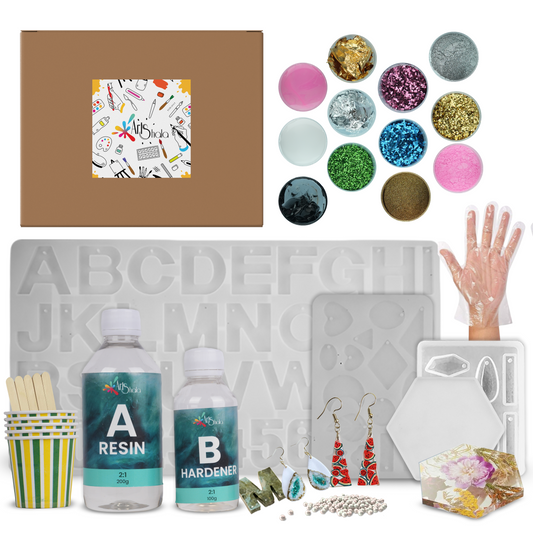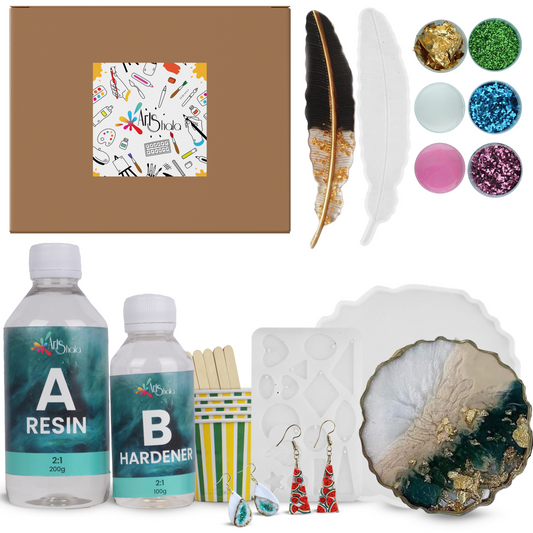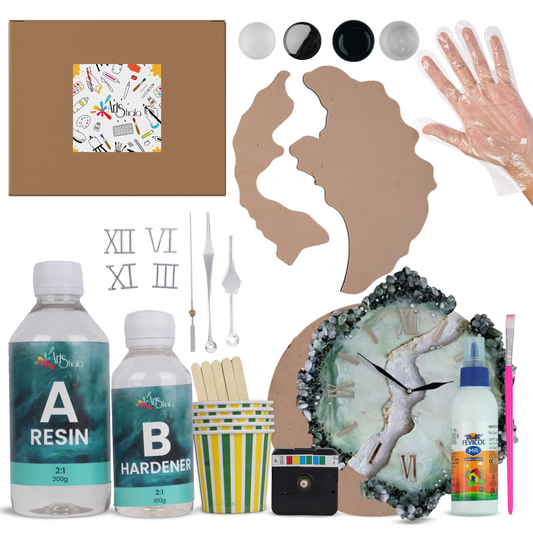How to Make a Layered Resin Painting? A Complete Guide
A layered resin painting is a captivating art form that creates depth and dimension by adding multiple layers of resin and paint to a canvas. Due to their unique visual appeal and versatility, the popularity of layered resin paintings has been steadily growing in the art community.
If you're eager to explore this form of resin art, consider joining a resin art workshop to gain hands-on experience in making layered resin paintings. In this blog, we will guide you through the steps of creating a layered resin painting, from selecting the suitable materials to applying the final finishing touches. So, let's get started!
Materials Needed for a Layered Resin Painting
To create a stunning layered resin painting, it is essential to use high-quality materials. Using suitable materials will ensure the best results and enhance your artwork's durability and longevity. Here is a list of materials you will need for a layered resin painting:
- Canvas: Choose a stretched canvas or cradled wood panel as your painting surface. Make sure it is properly primed and ready for paint.
- High Gloss Resin: Opt for a high-quality resin designed for art projects that provides excellent clarity, UV resistance, and self-levelling properties.
- Acrylic Craft Paint: To create your layered design, select a range of vibrant acrylic craft paints. You can choose any brand that offers quality pigments and good coverage.
- Paintbrushes: Use a variety of brushes to achieve different effects and textures in your painting. Flat, round, and fan brushes are great options for your arsenal.
- Gold Leaf or Gilding Adhesive: If you want to add a touch of luxury and gloss to your artwork, consider using gold leaf or gilding adhesive. This optional element can create stunning accents and highlights.
- Gloves: Protect your hands from potentially harmful chemicals and ensure cleanliness by wearing disposable gloves throughout the process.
- Mixing Cups and Stirring Sticks: Use plastic mixing cups with measurement markings to mix resin and paint accurately. Wooden or silicone stirring sticks are ideal for thorough mixing without introducing air bubbles.
- Cardboard Box: A cardboard box slightly larger than your canvas will be a dust-free environment during the resin curing.
- Mini Torch, Heat Gun, or Straw: These tools remove air bubbles that may form when pouring resin onto the canvas.
Step-by-Step Guide to Making a Layered Resin Painting
When you make a layered resin painting, the first step is crucial to ensure a smooth and successful process. Here's a detailed guide on preparing the canvas and paints for your masterpiece:
Step 1: Preparing the Canvas and Paints
Canvas Preparation: Before you start, you must prepare your canvas correctly to achieve the best results. Here's how:
- Gently sand the surface of the canvas to create a slightly rough texture. This helps the paint and resin adhere better.
- After sanding, make sure to wipe off any dust particles with a clean cloth.
Priming: Once the canvas is sanded, apply a coat of primer to create an even layer for your artwork. Here are the benefits:
- Enhances adhesion of paint and resin.
- Prevents the canvas from soaking up too much resin later on.
Brushy Stroke Pattern Technique: Consider using a brushy stroke pattern technique with acrylic craft paint for the first layer of your painting. Here's how it works:
- Apply thick, creamy paint to the canvas using bold brushstrokes.
- The goal is to create an exciting and textured base for building subsequent layers.
By properly preparing your canvas and utilising the brushy stroke pattern technique, you establish a strong foundation for layered resin painting. This sets the stage for adding depth, texture, and visual interest as you progress through the remaining steps.
Step 2: Adding Depth with Multiple Layers
Creating a layered resin painting involves building depth and dimension with each layer of resin and paint. To achieve a splotchy and random effect, particularly for floral designs, follow these steps:
- Apply the second layer of paint randomly and organically, focusing on creating depth and texture.
- Use thick, creamy paints to build up layers that add visual interest and complexity to the painting. This technique is reminiscent of how oil paintings often have more depth than acrylic paintings, which can be quite impactful.
- Experiment with different colours and transparencies to create a dynamic composition.
Step 3: Incorporating Additional Elements
Preparing the canvas for layered resin painting is crucial in a layered resin painting tutorial. After achieving depth and dimension with multiple layers, it's time to elevate the artwork by incorporating additional elements.
- Provide an overview of the entire process before diving into the steps
- Adding additional elements to layered resin painting
Consider incorporating elements such as gold leaf or gilding adhesive in your artwork to add visual interest and tactile appeal. These materials can introduce captivating textures and a luxurious sheen to your piece, elevating its overall aesthetic. Experiment with different application techniques and placements to create unique effects complementing your layered resin painting.
Remember, when using gold leaf or gilding adhesive, it's essential to prepare them properly before applying them to your artwork. This ensures that you achieve the desired result and that the materials adhere correctly.
Step 4: Sealing and Finishing the Painting with a Final Resin Coat
Applying a smooth and even final coat of resin is crucial to completing your layered resin painting. This final resin coat will seal your artwork and enhance its overall look. Here's how you can achieve a flawless finish:
- Mix the Resin: Use accurate measurements to achieve the desired consistency. Use a separate mixing cup and stirring stick for each batch of resin.
- Apply the Resin: Pour the mixed resin over your painting, starting from one corner and working your way to the other. Use a spreader or brush to evenly spread the resin over the entire surface, covering all areas.
- Eliminate Bubbles: To remove any air bubbles that may have appeared during the pouring process, you can use a mini torch, heat gun, or even gently blow through a straw. Move the heat source or straw slowly across the surface of the painting to distribute heat evenly and pop any bubbles.
- Allow Curing Time: After applying the final resin coat, allow your painting to cure for at least 48 hours in a dust-free environment. This will ensure that the resin hardens entirely and provides a durable finish.
Following these steps, you can create a gorgeous layered resin painting with a smooth and glossy finish. Remember to exercise patience during the curing process to obtain optimal results.
Conclusion
Layered resin painting can be a rewarding and creative art form. You can transform your artwork into a visually appealing masterpiece with suitable materials and techniques. Take your time, follow the steps carefully, and enjoy the process of creating a unique and eye-catching resin painting. These tips allow you to embark on your layered resin painting journey confidently. Experiment with different colours, techniques, and designs to create your own personal style. The possibilities are endless, and the results are sure to be mesmerising. To learn more about resin arts and crafts, Contact Us on Arts Shala today for workshops and courses from expert artists. So gather your supplies, set up your workspace, and let your creativity flow as you get into the art of layered resin painting.












